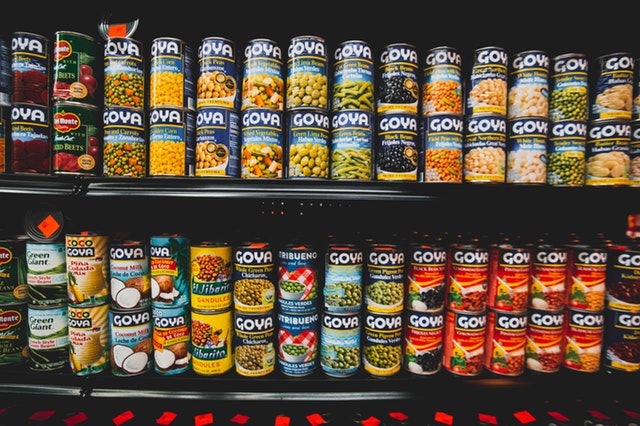
Image Source: Pexels
The process of canning food has given people a way to store food variants for approximately long time periods, and this began way back in 1825. This process allows you to boil certain food in the can in order to destroy all sorts of bacteria. Once done, the can is sealed to prevent bacteria from contaminating it.
The food inside the can is completely sterile, therefore it will not spoil. However, once you open it, bacteria will surely enter and will contaminate the food inside. This is one of the major reasons why you need to refrigerate the remaining content after opening the can.
“Cans are metal” is what most people often thought. However, any container that is sealable can be a can. Say, for example, glass jars, these containers can be boiled and covered. This goes the same with plastic pouches or boxes. A box of milk is sterile, by means of ultra-high temperature pasteurization (UHT). It will then be sealed, so as not to spoil the content when stored at room temperature.
The Aspect of Modern Canning
Despite the innovation of industries and processes, the canned food principles have not been drastically modified since Peter Durand and Nicholas Appert developed the method. Enough source of heat to kill bacteria and other microorganisms is used to food content packed into covered containers.
After the sealing process, the food content placed inside the cans is heated. The temperature for the steam pressure process should be at 116-121° Celsius. During this process, globe valve manufacturers must ensure the quality of valves being used.
In every food being processed, the duration of time required varies on the density, acidity, and the ability to move heat. For example, tomatoes need less process time than mung beans, whilst pumpkin and corn need more. The condition of every process is selected to be at least under the minimum standard required, why? This is to make sure that food contents are sterile commercially, but the flavor remains as well as the nutrition.
All canned processes must undergo Food and Drug Administration’s approval. The moment the containers are completely heat processed and tightly sealed, the food content maintains its best quality for consumption for about one or two years. Not only that, but it should also be safe for human consumption, and containers should be free from possible damage. There should also be no added preservatives.

Image source: https://www.history.com/news/what-it-says-on-the-tin-a-brief-history-of-canned-food
The proper canning method steps varies with every product. Vegetables and fruits may be pitted or decorticated. The stems should be removed before entering the canning process. Other vegetables undergo heat treatment prior to placing them in the container in order to remove excess air. Juices that are acidic as well as vegetables, need to be sterilized prior to putting into the can.
As for meat, such as fish, the flesh must be softened prior canning, bones are separated and properly arranged inside the containers with the right amount of liquid volume. Seafood is often packed right after being shelled or boned.
The most obvious distinctness of before and today’s canned food process is the fact that most cans today are made from materials that are recyclable, specifically steel.
Packed with Freshness
To guarantee the freshness of food content, most facilities for canning process are situated closer from the area of harvest. Canning facilities for fruits and vegetables are usually located from the area where fresh pining facilities are situated close to the area of harvest, as some nutrients are diminished whilst during transport. Seafood canning facilities are just within a few minutes from the ports.
Soups and meats are packed within the area they are made and processed. Reducing transportation helps lower the costs and at the same time making sure that food content won’t lose its distinct flavor during the transportation process.
Nutrition Content for Canned Food
Apart from packing food during its harvest prime season, it should also be packed when nutrients are at its peak. Nutrients start to decrease as the food ages, particularly fruits and vegetables.
Moreover, food content like beans contains a higher content of fiber. Canned tomatoes, on the other hand, contain higher lycopene quantities, an important phytonutrient, than tomatoes that are freshly harvested.
The Advantages in Terms of Safety
The process of canning was made for the preservation of food in a safe way as well as for long storage duration. By the time the food is canned, the can will undergo heat treatment to a certain temperature that will destroy all known bacteria and microorganisms. Majority of canned foods are monitored using HCCP (Hazard Analysis and Critical Control Point) system.
This system determines different areas potential for bacterial contamination during the process of food canning. Checkpoints will be built in order to guarantee the highest safety standards possible. Advanced processors are closely monitored during the heating process to ensure that all canned food is safe for consumers.
Canned Food of Today
Food that is being harvested and packed are often placed inside a container. Factually speaking, a lot of food varieties were readily made available through cans and other similar containers for decades. As of this present time, consumers have more choices and can even find alternatives like frozen goods to canned food. However, canned food contents remain the most vital part of every consumer’s need.
Conclusion
Canned food is by far the most convenient food source before and even today. Whether going on a trip, camping, or vacation, canned food will always be our best handy meal option. Knowing its basic procedure helps us to understand more how canned food is made and processed and that certain canning process is done on different food varieties.
About The Author:
Chris Young is a dedicated family man who loves to write whenever he gets the chance. He used to be a teacher before shifting to becoming a full-time father and writer. His goal is to share with others his knowledge and experience on things that relate to family and home. He and his wife share a beautiful home in Northern California with two beautiful daughters. If you want to reach out to him, you can do so through his email add: chrisyoungbiz1982@gmail.com.




